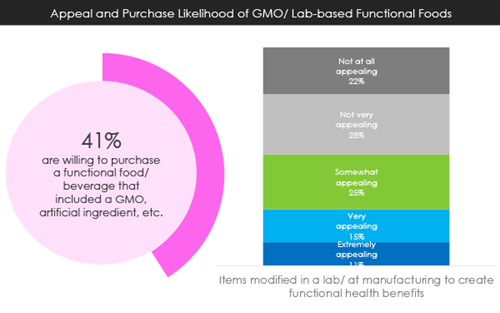Functional foods are all the rage. That much everyone knows. It’s time to dive deeper into what “all the rage” might mean for you and your business.
But first, a definition: The Mayo Clinic defines functional foods as “foods that have a potentially positive effect on health beyond basic nutrition.” It lists oatmeal as one familiar example because it contains soluble fiber that can help lower cholesterol levels and orange juice that has been fortified with calcium for bone health as another.1
Here are our top five insights about functional foods reinforced by new research from Datassential.
Insight #1: It’s important to know who is (and isn’t) behind the wheel.
Of the 90 percent of consumers expressing interest in functional foods, three sub-categories seem to be driving things: higher-income consumers, non-white consumers and consumers with children. While millennials show somewhat higher interest, they may not be a primary driver for continued category growth.2

Insight #2: Don’t try to be all things to “functional” people.
Consumers want products that deliver specific health benefits.2 Generalize to your peril. Is this functional food going to help someone sleep better, reduce stress or improve immune function? If you want to move the needle, it’s important to identify the function by name.
Insight #3: Science-supported sells.
Research shows 66 percent of customers are more likely to purchase a food or beverage item featuring a functional health benefit that is accompanied by scientific data or a scientific claim. 2
Insight #4: Lab-adapted? Not so much.
Half of research respondents found it “not at all appealing” or “not very appealing” to include anything they perceive to be “unnatural” in their functional foods, such as GMOs, artificial ingredients or any other lab modifications.2 (Marketers, remember that label claims are fostering some of these perceptions.)

Insight #5: Big players have developed a big appetite.
Large food and beverage companies are moving rapidly into this space. For example, Mondelez recently took a minority stake in Uplift Food, an early-stage startup focusing on prebiotic functional foods like Organic High Vitamin D Mushrooms that offer “… anti-inflammatory Vitamin D to support immune and bone health, plus mood regulation.” Expect more moves like this to come.
As further evidence of the trend’s staying power, Forbes recently reported that Whole Foods, Food Business News and Kroger all listed gut-healthy foods as one of the top trends in 2019.3
The desire for what one might call “customized nutrition” is emerging as a strong driver for consumers. Perhaps what you raise or produce could deliver a yet-untapped functional food benefit if you thought of it in those terms (backed by research). Consider it.
Our team at Charleston|Orwig helps strategic marketers develop, craft and deliver insightful communications that can help you reach your sales objectives. We work with new, emerging and established brands—from startups to global stalwarts. When the time is right, give us a call to talk about how we might help you solve a marketing problem. Mark Gale: mark.g@co-nxt.com.
1Mayo Clinic website: https://www.mayoclinic.org/healthy-lifestyle/nutrition-and-healthy-eating/expert-answers/functional-foods/faq-20057816
2Functional Food Report, Datassential, 2018
3Forbes Magazine: https://www.forbes.com/sites/arielknoebel/2018/12/18/gut-health-and-functional-foods-top-charts-of-2019-food-trends/#8f5b4dd6ea4a
C.O.nxt Insight.
Our team of subject matter experts focuses on food and agriculture—farm field to processing to entrée on a plate. We can help you build a new brand, protect an old one or target customers to foster sales. Let’s talk when the time is right to handle your next strategic marketing and communications challenge: Marcy Tessmann, marcy@co-nxt.com.
SHARE THIS STORY
Charleston Orwig Collective Earns Wisconsin Titan 100 for Second Consecutive Year
HARTLAND, Wis. (October 15, 2025) — The Charleston Orwig Collective, comprised of Milwaukee-based full-service agencies C.O.nxt and Jigsaw, announced today that President and CEO, Marcy Tessmann, has been named to the Wisconsin Titan 100 list for the second consecutive year.
